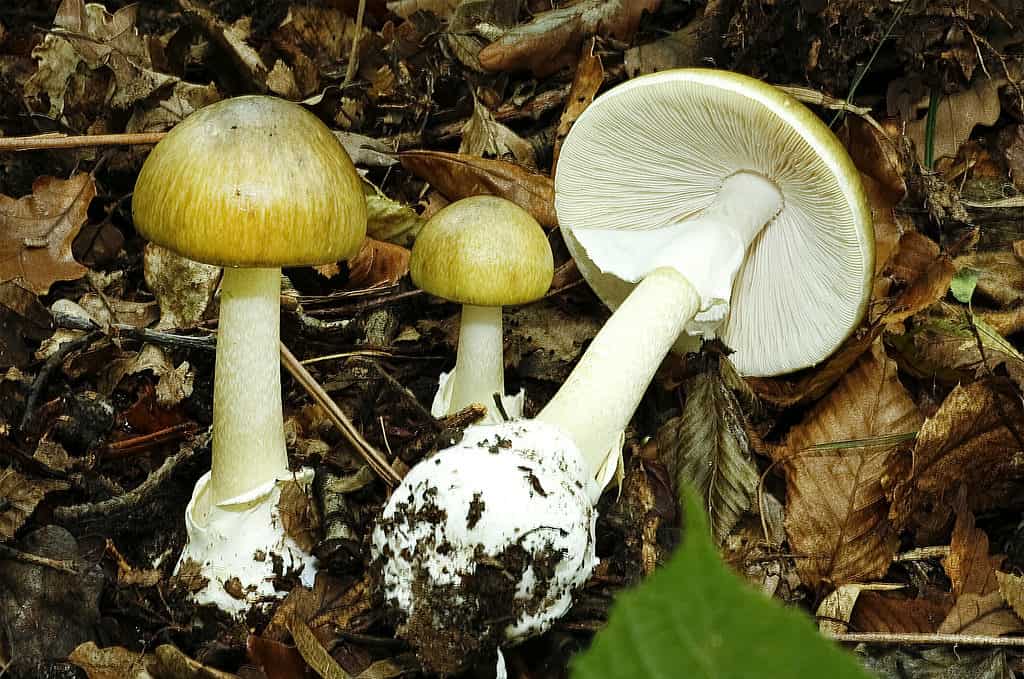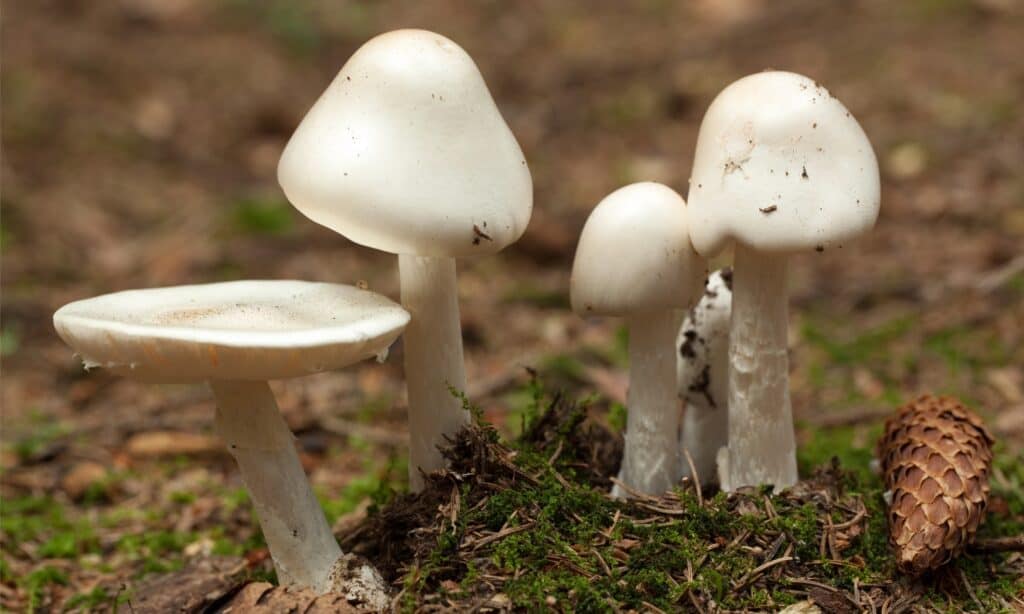Death Cap Mushrooms vs Destroying Angels
The wonderful world of amanitas contains some seriously intriguing, and seriously toxic mushrooms.
In this guide, we’ll compare death cap mushrooms vs. destroying angels by describing their fungal classifications, morphological characteristics, native growing range, ecological roles, and main toxins present in each mushroom.
Read on to learn more.
Death Caps vs. Destroying Angels: Fungal Classification
Death caps and destroying angels are common names of species found in the Amanita genus of the Amanitaceae family of mushrooms. While many species in the Amanita genus are edible, such as all in section Caesareae, some 80-100 species in other sections of the genus are deadly poisonous. These poisonous mushrooms in Amanita contain deadly toxins and are responsible for over 90% of fatal mushroom poisonings of humans worldwide. By and large, only expert mushroom hunters should consume edible mushrooms in the Amanita genus, as many species look quite similar, especially to the un or under-trained eye.
Death Caps
The scientific classification of death caps is Amanita phalloides. It belongs to section Phalloideae of the Amanita genus. In taxonomy, a section is the taxonomic rank below the genus and above the species. It is a grouping of species.
Distribution
This mushroom is native and widely distributed across Europe. However, since the late 20th century, people have, largely inadvertently, introduced this mushroom to various temperate regions around the world. Likely, Amanita phalloides arrived in North America attached to the roots of imported, ornamental trees. in North America, currently, Amanita phalloides occurs the most along the West Coast. This species is especially abundant around the San Francisco Bay Area of California. On the East Coast, it is somewhat rare, but this species is most prevalent from the Mid-Atlantic to the Northeast.
Death Cap Mushrooms vs. Destroying Angels: Ecological Roles
Like the vast majority of mushrooms in Amanita, death caps are mycorrhizal. This means they derive their nutrients through an intricate partnership with the roots of plants. The mycelium, the underground filamentous network of the fungus, moves throughout the soil, scavenging nutrients and water. It brings back water and nutrients, such as phosphorus and magnesium, to the plant’s roots. In exchange, the plant provides the fungus with carbon and sugars. Over 80% of all plant species form mycorrhizal relationships with fungi, although the majority of these fungi form mycelium but do not form fruiting bodies (aka mushrooms).
In the case of Amanita phalloides, this species primarily forms mycorrhizal relationships with various species of oak trees. On the West Coast, death caps have a particular affinity for coast live oaks (Quercus agrifolia). They tend to fruit from mid-summer through fall.
Morphological Characteristics
Amanita phalloides shares similar characteristics with several mushrooms in the Amanita genus. Like many of its Amanita relatives, this mushroom has white-pale gills that are free from the long, slender stem (aka the stipe), a white spore print and a non-slimy cap. Some other attributes that are shared with many, but not quite as many amanitas, are universal veil remnants (protective membrane) and a saccate volva (a cup-like structure) at the base of the stipe.
Universal and Partial Veil
When immature, the death cap mushroom is protected by a universal veil. This structure is a white, egg-like membrane that completely covers the developing mushroom.
In order to see the developing cap, stipe, and gills, you must cut the universal veil vertically down the center. As the mushroom grows, it breaks through the universal veil, leaving a cup-like structure at the base of the stipe (the volva).
A partial veil continues to cover the gills of young specimens until the cap expands outward and breaks the veil, revealing the gills. On Amanita phalloides, you can see remnants of the partial veil around the upper portion of the stipe. This partial veil remnant is called an annulus or veil ring.
Cap
As it matures, the cap expands outward until it resembles a flattened disc shape. At this point, you can clearly see the pale gills underneath the cap. Typically, the cap color of Amanita phalloides is pale olive green-yellow or tan-light brown. At maturity, the cap is usually 4 to 6 inches across.
Gills
The gills of a death cap should look like fleshy slits that are crowded closely together and radiate outward from the center of the cap. On Amanita phalloides, the gills do not connect to the stipe. Instead, as freely attached gills, there is a thin ring underneath the cap that separates the gills from the stipe.
Stipe
The stipe of a mature Amanita phalloides is long, slender, white, and not hollow. It can grow up to 8 inches tall. You may notice the remnants of the universal veil on the stipe as chalky, delicate, and shaggy pieces of membrane. A veil remnant ring surrounds the upper portion of the stipe. At the base of the stipe, you will see a white, egg-like structure. This is the saccate volva, another remnant of the universal veil.

©el_cigarrito/Shutterstock.com
Death Cap Mushrooms vs. Destroying Angels: Toxins
In Amanita phalloides there are three main groups of toxins: amatoxins, phallotoxins, and virotoxins. Out of these three toxin groups, amatoxins cause the most harmful effect on the human body. Amatoxins are particularly poisonous to the liver and kidneys. While phallotoxins and virotoxins can damage the liver, injection or inhalation of these two toxin groups is typically necessary to cause harm as phallotoxins and virotoxins are mostly destroyed in the digestive tract.
Amatoxins, however, are deadly poisonous upon consumption. Typically, after initial gastrointestinal distress 6-24 hours after consumption, a poisoning victim experiences a latent period for 2-3 days in which they appear to be recovering. However, significant damage to the liver and kidneys is taking place during this time. Between days 3-7, the poisoning victim may experience acute liver or kidney failure, coma, or even death.
Destroying Angels
There are many species in Amanita, mostly in North America, Europe, and Asia, that contain the common name of destroying angels. In North America, some of these species include:
- The Eastern North American destroying angel (Amanita bisporigera)
- The Western North American destroying angel (Amanita ocreata).
- The great felt skirt destroying angel (Amanita magnivelaris)
- The U.S. version of Amanita virosa (Amanita amerivirosa)
- Atkinson’s destroying angel (Amanita elliptosperma)
- Narrow-spored destroying angel (Amanita virosiformis)
Like the death cap, destroying angels belong to the section Phalloideae of the Amanita genus. In this guide, we’ll focus on the common characteristics shared by most destroying angels.

©iStock.com/dabjola
Death Cap Mushrooms vs. Destroying Angels: Ecological Roles
Like Amanita Phalloides, destroying angels are mycorrhizal, forming symbiotic partnerships with the roots of host plants. Most North American destroying angels primarily form mycorrhizal relationships with oak trees. Like death caps, in North America, they tend to fruit from mid-summer through fall.
Morphological Characteristics
While various macroscopic distinctions do exist between species of destroying angels, these mushrooms do contain a number of broad, overlapping morphological characteristics. These common characteristics include the following:
- Stark white coloration of the fruiting body outside of the top of the cap, including the flesh, gills, and stem (stipe).
- Immature destroying angels are encased in a white, egg-like membrane called a universal veil.
- A partial veil covers the gills of young specimens.
- A white spore print.
- The presence of thin, delicate, white gills under the cap that don’t connect to the stipe. A thin ring of space separates the gills from where the stipe and cap meet (freely attached).
- Similar fruiting body structures. All destroying angel species feature similarly long, slender stipes that tape toward the cap and have a cup-shaped bulb (saccate volva) at the base. Mature caps expand into almost flat discs.
The major difference between these mushrooms is the color of the pileus (the cap). The death cap is an olive-green color or similar, while the destroying angels are white.
Death Cap Mushrooms vs. Destroying Angels: Toxins
Like Amanita phalloides, destroying angels contain amatoxins. If ingested, a poisoning victim will experience the same poisoning timeline as detailed in the death caps section of this guide.
Fast medical intervention is crucial to the chances of recovery from amatoxin poisoning. Besides death or coma, liver and kidney failure, requiring transplants, is not uncommon with late intervention. If taken quickly to the ER after a death cap or destroying angel poisoning, supportive care and intravenous silibinin treatment may prevent liver or kidney failure. If you suspect poisoning from an amatoxins-containing mushroom, try to remember to take a sample of the mushroom (if any remains) in a ziplocked bag to the hospital.
The information presented on or through the Website is made available solely for general informational purposes. We do not warrant the accuracy, completeness, or usefulness of this information. Any reliance you place on such information is strictly at your own risk. We disclaim all liability and responsibility arising from any reliance placed on such materials by you or any other visitor to the Website, or by anyone who may be informed of any of its contents. None of the statements or claims on the Website should be taken as medical advice, health advice, or as confirmation that a plant, fungus, or other item is safe for consumption or will provide any health benefits. Anyone considering the health benefits of particular plant, fungus, or other item should first consult with a doctor or other medical professional. The statements made within this Website have not been evaluated by the Food and Drug Administration. These statements are not intended to diagnose, treat, cure or prevent any disease.









